- Heating
- Posted
Taking control
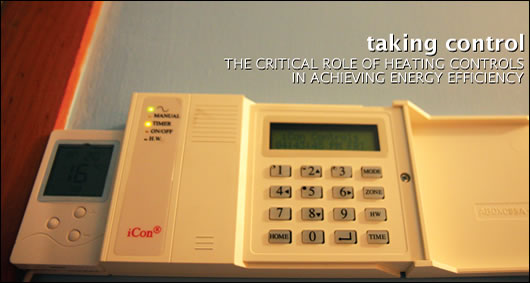
Buildings that are designed or refurbished to use little energy all too often fail to deliver the expected performance, if the building occupants aren’t able to use the building as intended. John Hearne reveals the crucial role that user-friendly heating controls play in ensuring that a theoretically low energy building delivers the expected results.
Heating controls in Ireland, historically at least, meant an on/off switch. More recently, sophistication came in the form of a time-clock which can only be used by people with long nails or tiny fingers. When it comes to energy refurbishment, it’s all about wall and attic insulation, condensing boilers and renewable technologies, but very rarely do you hear anything about the system of controls to tie it all together. And yet, the figures suggest that good, user-friendly controls have the potential to contribute more to energy savings than any other single measure.
Paul Kenny of Tipperary Energy Agency (TEA) points to the strange anomaly that, although domestic lighting controls are taken for granted, we just don’t have the same attitude to the way in which we manipulate the heat coming into our homes. “You don’t come into your house and switch on every light in the entire house with one switch, and all to the same brightness. You put a smaller bulb in one room, then you put a switch in each room, so you’ve individual time control on your lights and the size of the bulb is appropriate to the room you’ve put it in. We just don’t do this with heating controls.” And yet lighting a house doesn’t require anything like the energy needed to heat a house. “I did the maths there today with a home owner who was thinking of putting in good heating controls. I asked him ‘how much is your heating bill?’ He said ‘It’s about two fills a year.’ So I said, ‘Ok, that’s about e1,500 a year we’ll say. Divide that by 200 days, that’s about e7 a day, give or take. He maybe has ten rooms heated, so that’s 70c per room per day. If you think about lighting for one room you wouldn’t spend any more than 10c a day for the most energy inefficient lighting, so heating is seven or eight times more expensive per room in winter, yet we don’t have any control of it.”
Tipperary Energy Agency was one of the three agencies to administer the recent Home Energy Saving scheme pilot, in which grant aid was made available for energy makeovers to 1,500 houses built before 2002. With that pilot now concluded, the data which it has turned up, particularly in the area of heating controls, shows just how far behind the curve the housing stock has fallen. “Turning down your thermostat by one degree is all well and good,” says Kenny, “but 82 per cent of the houses we surveyed didn’t have a thermostat to turn down…You’d ask them do you have heating controls and they’d look at you. Do you have a heating switch? ‘Oh yeah it’s out here,’ and they bring you out to the garage. Controls need to be in the kitchen where you’ll see them every day.” The sample of homes included in the scheme represents a tiny percentage of the total pre-2002 housing stock in the country. Though it is slightly skewed towards rural homes, it’s not unrepresentative of what’s out there. “98 per cent of houses surveyed in 1,500 homes under the pilot did not have a stat on the cylinder,” says Kenny, “so almost every cylinder in the country is overheating.” In the absence of any control on hot water temperature, the water in the tank equalises with the temperature that’s coming out of the boiler. That’s usually 75 degrees, about 20 degrees hotter than it needs to be. From his experience on the ground with the home energy surveys, Kenny has dozens of stories involving poor heating controls, no heating controls and most particularly, bad behaviour. “I was in a house the other day, they had an oil-fired range to heat their water. It was one of these really old wick-type ones. They light the wick in the morning, and off they go to work. The range heated up and heated up all the water. Once the water was hot, it would dump to a radiator, and when that room got too warm, they’d open a window. That is heating controls in Ireland. A plumber put that in and said this is a good idea.”
Like many of our energy problems, this, in part at least, is a hangover from the days when energy was cheap. There are however particular reasons why a failure to deal properly with the control issue is endemic in Ireland. “If you start at the beginning,” says Kenny, “whether you’re talking about homeowners, plumbers, energy efficiency experts, building energy raters, whoever it is; there’s a generally poor knowledge of heating controls…There’s a significant requirement for plumbers to do energy efficiency upgrade training.” He says that this lack is a subset of a more general failure in the building industry to engage properly with energy efficiency. “But whereas new build has come up to speed a little bit, retrofit hasn’t, and nor is your average plumber really up to speed yet.” As with so many of the problems that arise in the construction industry, the issue has its roots in the lack of any building control in Ireland.

Paul Kenny of Tipperary Energy Agency talking to John Hearne
“One in forty houses built since 1997 are compliant to part L of the 1997 building regulations.” says Michael Meehan of heating and energy consultants, Ecosave. “A lot of the reason for that is the inadequate level of training…But the big problem is the lack of building control.” He points out that the requirement for zoned time and temperature controls and boiler interlock (an arrangement of controls to ensure that the boiler doesn’t fire when there is no demand for heat) has been in the building regulations for eleven years. “In Ireland, the emphasis has been get it in, get it working, then good luck. In the majority of houses in Ireland, the only level of heating control they have is boiler thermostat and time-clock.” Like Paul Kenny in Tipperary, Meehan believes there’s a major skills gap among both plumbers and electricians when it comes to installing controls. Because a successful install requires sequenced input from both trades, you need a high degree of coordination, and that’s just not there. As a result you get a lot of grey area, and essential jobs falling between stools. Moreover, things are about to get worse. As it stands, says Meehan, electricians have problems with basic zoned controls, now there are even more sophisticated systems – MBus technology, low voltage systems - coming down the line.
There is some good news on this front. Joe Durkan of SEI reports that the National Standards Authority of Ireland (NSAI) has rewritten the plumbing and heating best practise guide. That document, he says, should be ready early this year. “That’s a comprehensive guide for the plumbing industry and anyone that’s involved in heating services. It focuses not only on the workmanship side of things but on the sizing and the effects of controls… Following on from that, we would have plans to provide add-on courses for qualified plumbers and heating engineers that would focus on the efficiency side of things, and of course part and parcel of efficiency is the controls.” In addition to this new code of practise, the 2008 Building Regulations, which came into effect in July, specify control systems in much greater detail than ever before.
But while the new code of practise may address competency issues with plumbers, Michael Meehan points out that it will do nothing to address the deficiency on the electrical side of the house. “I only had it two days ago with a very experienced electrician. We were wiring a control system and he said, ‘I’ve never seen it wired like that before.’ This was a house that was simply being done to Part L of the regs.” The solution, he believes, lies in the creation of a new, separate classification. “There needs to be a separate trade of heating engineer, someone who would be in a position to design, install and commission all of the mechanical and electrical elements to do with heating systems.” In the UK, where Meehan worked during the eighties, they overcame overlap issue between plumbers and electricians by introducing a competent person’s scheme, which gave technicians the requisite skills to bring an installation right through to the end.
So what comprises good control? “The more zones you have, the better,” says Kenny, “but in the case of the average Irish home that’s been built in the last ten or fifteen years, they should have bedrooms on one zone, living areas on another zone and water on a third zone. What’s important there is you have both individual temperature control in each of those zones and individual time control in each of those zones. Finally, you’ve got to make sure that the home owner can use those controls effectively too.” Of course, unlike wall insulation, control systems rely on human behaviour to deliver the potential savings. There’s not much point fitting a state of the art system unless the humans involved have the capacity and inclination to use it.
Michael Hanratty of energy charity Energy Action has had a good perspective on how control systems are used, or not used as the case may be. As part of the 3-year EU Datamine project, which seeks to develop comparable energy rating data across 12 EU states, Energy Action audited 78 Dublin City Council houses before and after major energy refurbishments. They found that the addition of controls was instrumental in reducing heat requirements on average to less than a quarter of what they had been. “In some cases,” says Hanratty, “they might just have had a solid fuel back boiler, in other cases, they might have had older oil and gas boilers with no control other than a timer…We were able to look at what made a big difference and what made a little difference; controls actually contributed significantly to an improvement in the BER.” But when those controls lack user friendliness, those potential savings won’t be realised. The standard time-clock, with its 48 tiny tabs is notoriously difficult to manipulate. “When my mother goes to open a carton of milk,” says Hanratty, “she takes out a big scissors. She has arthritis in her hands, and some of these controls are quite impossible to work…My mum goes at that timeclock with a torch. And she’s quite representative of people of that era and yet these people are people for whom heat is very, very important for comfort and health.”

Seamus Hoyne of Tipperary Energy Agency
Difficulties with controls are not restricted to either legacy systems or older people. In one local authority estate in Inchicore, Energy Action found that in all 22 homes, which were only five years old, none of the householders could negotiate their heating controls. “Not one out of the twenty houses we visited actually knew how to programme a timer, none of them knew that they had a hot water cylinder thermostat…We had one house which was dramatically overheated, you had a lady who was a single parent, on social welfare, struggling to make ends meet. It was a freezing day in February and all the kids in the house were running around with their shirts off. It was about 27 or 28 degrees in the house.” To answer these issues, Energy Action has been seeking support to establish energy advice programmes. “The local authority may well have given advice when these systems went in, but you need advice more than once; you need someone locally to whom you can say, ‘can you ever come in and have a look at this for me?’”
Seamus Hoyne of the Tipperary Energy Agency tells a very similar story. He points out that a house with an A or B rating will not perform to that standard unless the occupant is using the systems as they are intended. The problem is one of a basic disconnect between designers and occupiers. “Generally people would move into a house and there would be no handover in terms of understanding how the house works. And that goes from local authority houses right through to private houses, where a house is built, the heating system is put in with programmable timers and condensing boilers, ventilation and all the bits and pieces. There might be manuals but they’re just left there, so people don’t get a run through.” Most of us come from a background where control at its most sophisticated means a timer switch. Confronted by zones and thermostats, many of us will just chicken out and revert to on/off mode. For some systems, this kind of approach just won’t work.
Controls, or the lack thereof, can have a critical effect on the performance of renewable energy systems as Unitherm Heating Systems, a design and supply company who integrate the control and mechanical aspects of heating systems, testify. “Controls are an essential element in any system, new or old, but particularly for systems using renewable technologies.” says Unitherm’s Darren Yourell. “System control can also be dictated by the heat sources installed. For example, some geothermal heat pumps have full heating controls already built-in, so integrating these controls into the entire system is extremely important to maximize efficiency, and interfacing with the electrical and heating installers is critical.”
Initially specializing in designing and supplying underfloor heating systems, Unitherm have always used zoned controls in their systems. “We include user friendly programmable room thermostats in all rooms and this adds to the efficiency and control of our systems. The individual room thermostats are linked into a central zone controller, which we can re-programme to prioritize the specific requirements of the end user, and this is the very heart of our controlled system” says Yourell. Unitherm also supply a comprehensive range of Alpha condensing gas boilers including models suitable for the retrofit or replacement markets. The boilers can be controlled by wireless user friendly easy-stats which eliminate unsightly wires when retrofitting and make it much easier to install controls within the system.
According to the Energy Saving Trust in the UK, the effectiveness of the controls has a significant effect on the operation of the whole system. “For example, for a normal 'wet' central heating system a 'basic' set of controls would comprise programmer, room thermostat, cylinder thermostat, boiler interlock, thermostatic radiator valves (TRVs) on all radiators (except those in rooms with a room thermostat) and an automatic bypass valve if required. Well-controlled systems can be more than 30 per cent cheaper to run than poorly controlled systems.”
Eurotech in Monaghan started out designing and supplying underfloor heating and geothermal systems, but, MD Gerard Duffy explains, the company ran into problems when it came to controls. Underfloor systems don’t provide heat on demand. “At the moment, you decide when to put heat into the floor, but that’s not the precise moment when you get that heat in the room, so you need a control system that can learn what the delay is and can then direct the heat at the precise time so you get heat when you want it. If you said you want 20 degrees at 8:00 in the morning, the control system would learn when it should put heat into the room so you can get that…The usual way is people would pre-empt it: I want the heat at 8:00 in the morning, I’ll set it to come on at 6:30. What happens in reality, if it was a mild night, 7:30 might have been time enough to set it going and if it was a very cold night, they might even have needed to put it in at 6:00 to have it warm at 8:00. What we were looking for was a system that would understand how the weather outside changes the turn-on time, so that you can get precisely the right turn-on time to give you the comfort within the timeframe you’re looking for.”
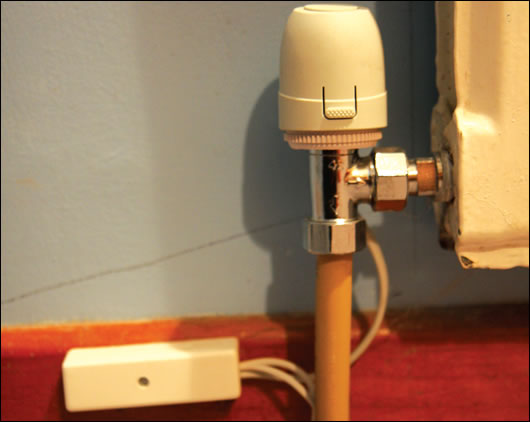
Comeragh Controls’ discretely wired TRV on a radiator in David Kirwan’s home
According to Eurotech’s calculations, this kind of precision can deliver savings of “at least 30 per cent”. Their Eurosmart systems are not however restricted to either un- derfloor or new build scenarios but can work perfectly with all legacy systems and with retrofits. “Take a common situation now where someone has put in a backboiler and they also have maybe a gas boiler and a solar panel. When the backboiler is lit, a sensor at the boiler picks this up, and the system will turn off the gas boiler and run the pump for the back boiler and use that energy instead of using the boiler…Stuff like that happens in the background without the customer worrying about it. It operates all of the devices in the heating system.” Eurotech’s system also has a ‘reduce temperature’ facility which drops rooms to a preset background temperature when not in use. This is particularly valuable with geothermal systems, because it allows a low grade heat be retained in the thermal mass of the building, making it much easier, faster and cheaper to bring the space back up to temperature when required. Weather compensation, an additional feature of Duffy’s system, also works particularly well with underfloor systems because it removes the risk of overheating in milder conditions. One thing Duffy is keen to emphasise is the essential role of any control system in tying diverse energy sources together seamlessly. “A control system must integrate with everything that is influencing heating in the house. Every mechanical item must be controlled by one central system, not by bits and pieces of timeclocks and thermostats and a whole lot of different things strung together. You’ve got to have a centralised control system with the intelligence to deliver the right temperature at the right time.”
Martin Carey of Comeragh Controls in Tipperary says that their system takes zoning to the nth degree, and instead of the conventional three zones – for living quarters, sleeping quarters and domestic hot water – they set up a separate zone for each room in the house. “With the three zone system that’s on the market at the minute, you can get on average 15 per cent savings, whereas ours will deliver about a 47 per cent improvement.”
“It’s not rocket science. Say a standard radiator produces 2kW per hour. If you’ve ten radiators in your house, between them they’re consuming about 20kWh between them. They’ll have a flow temperature into them from your boiler of about 70 degrees and a return temperature of 50 degrees. If you’ve no control in the room, they will continue to give off heat, irrespective of whether your house is insulated or not. It’s only when you turn off your boiler, or only when you turn off those zones that they stop using heat, irrespective of what else is going on…so what we say is, using this system, you turn on the radiators you need. So for example, if, out of your ten rooms, two of your radiators are on, instead of using 20kW, you’re using 4kW. There’s significant straight savings right there.”
The Comeragh Controls system is operated from a central electronic console, while room thermostats can override the programme temporarily if more or less heat is needed. “The thermostat functions like a light switch. You can go to your thermostat and say you want your zone to come in for one hour, two hours or three hours. That overrides whatever the schedule is. So you have a generalised schedule for the whole house but that’s only a general thing…you can walk into a room at any stage and activate it or deactivate it.” Carey estimates a payback period of between four and six years. The system itself is highly configurable and will integrate with all and any pre-existing systems. “Irrespective of what kind of heat source they’re using, we can configure it so that the system selects the heat source that’s cheapest at any one time.” It’s interesting to note that the DEAP software which generates building energy ratings will only credit up to three zones, so that any house with a Comeragh Controls system will almost certainly be more energy efficient that its BER suggests. “That’s a real bone of contention for us.” says Carey.

Happy homeowner David Kirwan and Martin Carey of Comeragh Controls
David Kirwan organised a complete energy refurbishment of his home after he discovered last winter just how much he was spending on gas. “We moved into our house in November of last year, and we ran out of gas completely about three weeks after we moved in. We got a refill and it lasted eight weeks exactly. We were shocked, because it cost about e700, so we ordered new gas and again it lasted eight weeks, so it was going down ten per cent a week.” A plumber came and confirmed that no, there were no leaks in the system. The same tradesman also told him there was nothing wrong with his aging boiler, despite the obviously very poor efficiency, and more worryingly, extensive discolouration about its body. Luckily, Kirwan sought a second opinion, and the new plumber told him he’d have to replace the old boiler immediately. He put in a new condensing gas boiler, beefed up his wall and attic insulation and installed Comeragh Controls’ system. “We’re absolutely thrilled,” he says, “ there was an instantaneous change. The house is retaining heat, it feels warmer than it was before, but having said that the heating is on a lot less than it was before.” Putting heat where it needs to be for as long as it needs to be there makes life a lot easier. “The front room isn’t in use during the week. We don’t allow the children to watch TV before they go to school, so we have the heating off in that room all week except on Saturday morning – we have it programmed to come on at 7:00 for an hour or two, so it’s a real easy thing to do.” The Kirwans also make use of the override thermostat in each room, on days when the pre-programmed heating profile isn’t quite working out. Installation itself happened with the minimum disruption. “They were in and out very quickly…The wires are very thin, they run down the architrave along the top of the door and along the top of the skirting…In a retrofit I really can’t see any other way of doing it.”
Good controls badly managed will mean the system won’t deliver on its potential, but of course, good controls well managed can make all the difference to heating bills. “If you did just your walls, attic and boiler,” says Paul Kenny in TEA, “you could expect to easily get a 30 per cent to 35 per cent saving but if you add something like the Comeragh Controls System and really manage it well, you could double that.”
- Articles
- Heating
- Taking control
- heat
- controls
- Tipperary Energy Agency
- home energy saving scheme
- Thermostat
- Datamine
- Energy Action
Related items
-
 New digital hub for sustainable building upskilling
New digital hub for sustainable building upskilling -
 Ecomerchant now stocking Herschel Infrared heating products
Ecomerchant now stocking Herschel Infrared heating products -
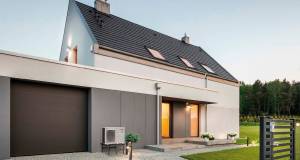 Panasonic welcomes new Green Homes Grant
Panasonic welcomes new Green Homes Grant -
 SuperHomes to ramp up retrofit with new EU funding
SuperHomes to ramp up retrofit with new EU funding -
 Energy Action to host 8th fuel poverty conference
Energy Action to host 8th fuel poverty conference -
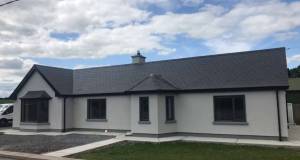 Sola Energy Solutions set for 50 deep retrofits this year
Sola Energy Solutions set for 50 deep retrofits this year -
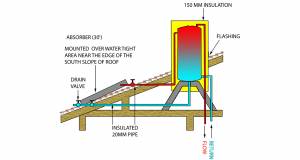 Marc O'Riain: The golden age of solar water heating
Marc O'Riain: The golden age of solar water heating -
 Internet of Things dominates ISH 2019
Internet of Things dominates ISH 2019 -
 Heat Merchants announces €4m expansion, 75 jobs & CO2 pledge
Heat Merchants announces €4m expansion, 75 jobs & CO2 pledge -
 Tipperary Energy Agency at 20
Tipperary Energy Agency at 20 -
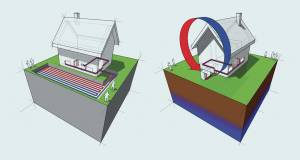 Heat pump grants - what you need to know
Heat pump grants - what you need to know -
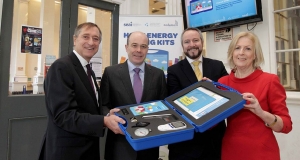 Codema launch energy saving kits in Dublin libraries
Codema launch energy saving kits in Dublin libraries

